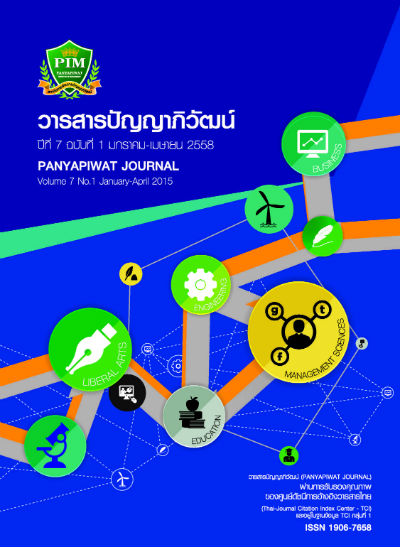THE PREDICTABILITY OF PAST FIRMS’ PERFORMANCE ON FUTURE CASH FLOWS
Main Article Content
บทคัดย่อ
Article Details
“ข้าพเจ้าและผู้เขียนร่วม (ถ้ามี) ขอรับรองว่า บทความที่เสนอมานี้ยังไม่เคยได้รับการตีพิมพ์และไม่ได้อยู่ระหว่างกระบวนการพิจารณาลงตีพิมพ์ในวารสารหรือแหล่งเผยแพร่อื่นใด ข้าพเจ้าและผู้เขียนร่วมยอมรับหลักเกณฑ์การพิจารณาต้นฉบับ ทั้งยินยอมให้กองบรรณาธิการมีสิทธิ์พิจารณาและตรวจแก้ต้นฉบับได้ตามที่เห็นสมควร พร้อมนี้ขอมอบลิขสิทธิ์บทความที่ได้รับการตีพิมพ์ให้แก่สถาบันการจัดการปัญญาภิวัฒน์หากมีการฟ้องร้องเรื่องการละเมิดลิขสิทธิ์เกี่ยวกับภาพ กราฟ ข้อความส่วนใดส่วนหนึ่งและ/หรือข้อคิดเห็นที่ปรากฏในบทความข้าพเจ้าและผู้เขียนร่วมยินยอมรับผิดชอบแต่เพียงฝ่ายเดียว”
เอกสารอ้างอิง
Barth, M. E., Beaver, W. H. & Hand, J. R. M. (1999). Accruals, Cash Flows and Equity Values. Review of Accounting Studies, 3, 205-229.
Barth, M. E., Cram, D. P. & Nelson, K. K. (2001). Accruals and the Prediction of Future Cash Flows. The Accounting Review, 76(1), 27-58.
Beaver, W., Kettler, P. & Scholes, M. (1970). The Association Between Market Determined and Accounting Determined Risk Measures. The Accounting Review, 45(4), 654-682.
Blitz, D., Huij, J. & Martens, M. et al. (2011). Residual momentum. Journal of Empirical Finance, 18(3): 506-521.
Charitou, A., Clubb, C. & Andreou, A. (2001). Permanence, Growth and Firm Size on the Usefulness of Cash Flows and Earnings in Explaining Security Returns: Empirical evidence for the UK. Journal of Business Finance & Accounting, 28(5).
Chung, R., Firth, M. & Kim, JB. (2003). Auditor conservatism and reported earnings. Accounting and Business Research, 33, 19-32.
Cooper, M., Gulen, H. & Schill, M. (2008). Asset growth and the cross-section of stock returns. The Journal of Finance. 63(4), 1609-1651.
DeAngelo, L. (1981). Auditor size and audit quality. Journal of Accounting & Economics, 3, 183-99.
Dechow, P. M. (1994). Accounting Earnings and Cash Flows as Measures of Firm Performance The Role of Accounting Accruals. Journal of Accounting & Economics, 18, 3-42.
Dechow, P. M., Kothari, S. P. & Watts, R. (1998). The Relation between earnings and cash flows. Journal of Accounting and Economics,25, 133-168.
Dhaliwal, D., Subramanyam, K. R. & Trezevant, R. (1999). Is Comprehensive Income Superior to Net Income as a Measure of Firm Performance?. Journal of Accounting and Economics,26, 43-67.
Doyle, J. T., Ge, W. & McVay, S. (2007). Accruals Quality and Internal Control over Financial Reporting. The Accounting Review, 82(5), 1141-1170.
Eisenhardt, K. M. (1989). Agency Theory: an Assessment and Review. Academy of Management Review, 14(1), 57-74.
Epstein, M. J. & Manzoni, J. F. (Eds.). (2004). Studies in Managerial and Financial Accounting,(Vol. 14). London: Elsevier.
Francis, J. R., Maydew, E. L. & Sparks, H. C. (1999). The Role of Big 6 auditors in the Credible Reporting of Accruals. Auditing: A Journal of Practice & Theory, 18(2), 17-34.
Finger, C. A. (1994). The Ability of Earnings to Predict Future Earnings and Cash Flow. Journal of Accounting Research, 32, 210-223.
Greenberg, R., G. Johnson & K. Ramesh. (1986). Earnings versus Cash Flow as a Predicator of Future Cash Flow Measures. Journal of Accounting, Auditing and Finance, Fall, 266-277.
Guan, L., He, D. & Yang, D. (2006). Auditing, Integral approach t quarterly reporting and cosmetic earnings management. Managerial Auditing Journal, 21(6), 569-581.
International Financial Reporting Standards Board, IASB (2008). International Financial Reporting Standards (IFRSs) 2008, Framework for the Preparation and Presentation of Financial Statements. London: International Accounting Standards Committee Foundation (IASCF).
International Financial Reporting Standards Board, IASB (2010). International Financial Reporting Standards. London: IASC Foundation Publications Department.
Jensen, M. C. & Meckling, W. H. (1976). Theory of the Firm: Managerial Behavior, Agency Costs and Ownership Structure. Journal of Financial Economics, 3(4), 305-360.
Johnson, H. T. & Kaplan, R. S. (1987). Relevance Lost - The Rise and Fall of Management Accounting. Boston: Harvard Business Review Press.
Kanagaretnam, K., Mathieu, R. & Shehata, M. (2009). Usefulness of comprehensive income reporting in Canada. Journal of Accounting and Public Policy, 28, 349-365.
Kaplan, R. S. & Norton, D. P. (1992). The Balanced Scorecard - Measures that Drive Performance. Harvard Business Review, January/February, 71-79.
Kennerley, M. P. & Neely, A. D. (2000). Performance Measurement Frameworks - a Review. Proceedings of the 2nd International Conference on Performance Measurement, Cambridge, 291-298.
Kim, M. & Kross, W. (2005). The Ability of Earnings to Predict Future Operating Cash Flows Has Been Increasing-Not Decreasing. Journal of Accounting Research, 43(5), 753-780.
McLaughlin, R., Safieddine, A. & Vasudevan, G. K. (1996). The Operating Performance of Seasoned Equity Issuers: Free Cash Flow and Post-Issue Performance. FM: The Journal Of The Financial Management Association, 25(4), 41-53.
Neely, A. (Ed.). (2007). Business Performance Measurement (2nd ed.). New York: Cambridge University Press.
Nunez, K. (2013). Free Cash Flow and Performance Predictability in Electric Utilities. Journal of Business and Policy Research,8(1), 19-38.
Ohlson, J. (1980). Financial ratios and the probabilistic prediction of bankruptcy. Journal ofAccounting and Research, 18, 109-131.
Schwerdt, W. & Wendland, M. V. (2010). Pricing, Risk and Performance Measurement in Practice: the Building Block Approach to Modeling Instruments and Portfolios, Elsevier, 377.
SIPA & NECTEC. (2010). Thailand IT Industry 2009, Software Industry Promotion Agency (Public Organization) & National Electronics and Computer Technology Center.
Vanichbuncha, K. (2010). Multivariate Statistical Methods. Bangkok: Dharmasarn co.ltd.


